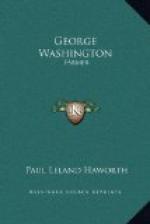He could have obtained vast land grants for his Revolutionary services, but he stuck by his announced intention of receiving only compensation for his expenses. He continued, however, to be greatly interested in the western country and was one of the first Americans to foresee the importance of that region to the young Republic, predicting that it would become populated more rapidly than any one could believe and faster than any similar region ever had been settled. He was extremely anxious to develop better methods of communication with the West and in 1783 made a trip up the Mohawk River to the famous Oneida or Great Carrying Place to view the possibilities of waterway development in that region—the future course of the Erie Canal. Soon after he wrote to his friend the Chevalier de Chastellux: “I could not help taking a more extensive view of the vast inland navigation of these United States and could not but be struck by the immense extent and importance of it, and of the goodness of that Providence which has dealt its favors to us with so profuse a hand. Would to God we may have wisdom enough to improve them. I shall not rest contented till I have explored the Western Country, and traversed those lines or great part of them, which have given bounds to a new empire.”
In partnership with George Clinton he bought, in 1784, a tract of six thousand acres on the Mohawk, paying for his share, including interest, one thousand eight hundred seventy-five pounds. In 1793 he sold two-thirds of his half for three thousand four hundred pounds and in his will valued the thousand acres that remained at six thousand dollars. This was a speculation pure and simple, as he was never in the region in which the land lay but once.
On December 23, 1783, in an ever memorable scene, Washington resigned his commission as Commander of the Continental Army and rode off from Annapolis to Mount Vernon to keep Christmas there for the first time since 1774. The next eight months he was busily engaged in making repairs and improvements about his home estate, but on September first, having two days before said good-by to Lafayette, who had been visiting him, he set off on horseback to inspect his western lands and to obtain information requisite to a scheme he had for improving the “Inland Navigation of the Potomac” and connecting its head waters by canal with those of the Ohio. The first object was rendered imperative by the settlement of squatters on part of his richest land, some of which was even being offered for sale by unscrupulous land agents.
With him went again his old friend Doctor Craik. Their equipage consisted of three servants and six horses, three of which last carried the baggage, including a marquee, some camp utensils, a few medicines, “hooks and lines,” Madeira, port wine and cherry bounce. Stopping at night and for meals at taverns or the homes of relatives or friends, they passed up the picturesque Potomac Valley, meeting many friends along




